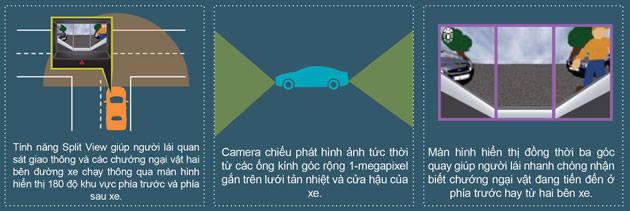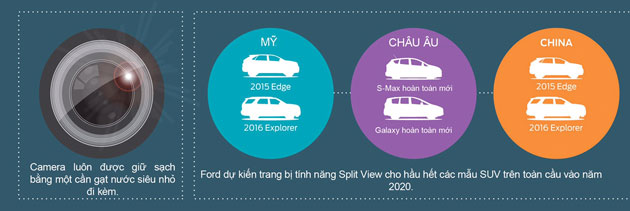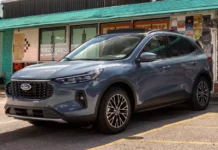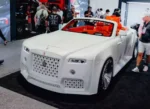Specifically, the new Split View camera feature allows drivers to observe traffic and obstacles on both sides of the road through a 180-degree display of the front or rear area of the car. This is the latest evidence of the brand’s improvements in the use of recording technology to make driving easier and safer.

The Split View feature is activated by a single touch button, using a camera that instantly transmits images from the 1-megapixel wide-angle lenses mounted on the grille and rear door of the car. The 8-inch screen simultaneously displays three angles of view to help the driver quickly identify obstacles approaching from the front or sides of the car.
On models equipped with Split View, the front camera is always kept clean by a super small water wiper. Especially with the Ford Explorer, this wiper is integrated for both the backup camera as well.

By 2018, the backup camera will become a standard feature on all Ford cars in the North American market, and by 2020, most of the brand’s vehicles in this region will also be equipped with a front camera. This means that from now until 2020, Ford plans to equip more than 2 million new cameras each year on its vehicle models.
Ford first introduced its backup camera technology on the 2007 Ford Expedition and now this technology is widely available on all Ford cars, SUVs, and light trucks in the North American market. It is also a standard feature on all Ford Focus, Fusion, Explorer, Escape, Edge, and Mustang models.
Also today, Ford announced that the next-generation Super Duty truck will be unveiled with the latest and most advanced recording technology, supporting lane-keeping assistance and allowing drivers to observe more angles around the car than ever before.
The new Super Duty model will be equipped with up to 7 cameras and a completely new digital architecture, affirming the brand’s leading position in the market for the most advanced recording technology, as well as helping drivers maneuver more skillfully in narrow spaces.
In addition, the 2016 F-150 model will also have up to 5 cameras – the most among the brand’s current vehicle models. Of these, four cameras are mounted on the outside mirrors, front and rear of the car, ensuring a 360-degree view and comprehensive rear-view monitoring function.
The front-facing camera is mounted right behind the rearview mirror and is used to activate the headlight system and the Lane-Keeping Aid feature – the system that determines lane deviation. While the driver cannot see the image from this camera, the vehicle’s computer will use these visual signals to control the rest of the system.
Minh Quan (TTTĐ)




































